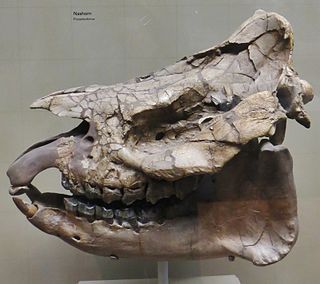
The Miocene is the first geological epoch of the Neogene Period and extends from about 23.03 to 5.333 million years ago (Ma). The Miocene was named by Scottish geologist Charles Lyell; the name comes from the Greek words μείων and καινός and means "less recent" because it has 18% fewer modern marine invertebrates than the Pliocene has. The Miocene followed the Oligocene and preceded the Pliocene.

The Neogene is a geologic period and system that spans 20.45 million years from the end of the Paleogene Period 23.03 million years ago (Mya) to the beginning of the present Quaternary Period 2.58 million years ago. It is the second period of the Cenozoic and the eleventh period of the Phanerozoic. The Neogene is sub-divided into two epochs, the earlier Miocene and the later Pliocene. Some geologists assert that the Neogene cannot be clearly delineated from the modern geological period, the Quaternary. The term "Neogene" was coined in 1853 by the Austrian palaeontologist Moritz Hörnes (1815–1868). The earlier term Tertiary Period was used to define the span of time now covered by Paleogene and Neogene and, despite no longer being recognized as a formal stratigraphic term, "Tertiary" still sometimes remains in informal use.

Dryopithecus is a genus of extinct great apes from the middle–late Miocene boundary of Europe 12.5 to 11.1 million years ago (mya). Since its discovery in 1856, the genus has been subject to taxonomic turmoil, with numerous new species being described from single remains based on minute differences amongst each other, and the fragmentary nature of the holotype specimen makes differentiating remains difficult. There is currently only one uncontested species, the type species D. fontani, though there may be more. The genus is placed into the tribe Dryopithecini, which is either an offshoot of orangutans, African apes, or is its own separate branch.

The Pantherinae is a subfamily of the Felidae; it was named and first described by Reginald Innes Pocock in 1917 as only including the Panthera species, but later also came to include the clouded leopards. The Pantherinae genetically diverged from a common ancestor between 9.32 to 4.47 million years ago and 10.67 to 3.76 million years ago.
Chilecebus is an extinct genus of New World monkeys that lived in what is now Chile during the Early Miocene some 20 million years ago. The type species is C. carrascoensis. It had a body mass of about 1,000 g (35 oz).

Prosantorhinus is an extinct genus of rhinocerotid that lived during the Early and Middle Miocene subepochs. The small teleoceratine rhinocerotid was found in Western Europe and Asia.
David Pilbeam is the Henry Ford II Professor of the Social Sciences at Harvard University and curator of paleoanthropology at the Peabody Museum of Archaeology and Ethnology. He is a member of the National Academy of Sciences. He received his Ph.D. from Yale University.

Chilotherium is an extinct genus of rhinocerotids endemic to Eurasia during the Miocene through Pliocene living for 13.7—3.4 mya, existing for approximately 10.3 million years.

Khoratpithecus is an extinct genus of pongin primates that lived during the late Miocene in Myanmar and Thailand.

Brachypotherium is an extinct genus of rhinocerotid that lived in Eurasia and Africa during the Miocene.

Diaceratherium is an extinct genus of rhinocerotid from the Oligocene and Miocene of Eurasia.
This paleomammology list records new fossil mammal taxa that were described during the year 2021, as well as notes other significant paleomammology discoveries and events which occurred during 2021.
This paleomammology list records new fossil mammal taxa that were described during the year 2022, as well as notes other significant paleomammalogy discoveries and events which occurred during 2022.
This paleobotany list records new fossil plant taxa that were to be described during the year 2022, as well as notes other significant paleobotany discoveries and events which occurred during 2022.
This list of fossil fish research presented in 2022 is a list of new fossil taxa of jawless vertebrates, placoderms, cartilaginous fishes, bony fishes, and other fishes that were described during the year, as well as other significant discoveries and events related to paleoichthyology that occurred in 2022.
Neonematherium is an extinct genus of scelidotheriid ground sloths that lived in Argentina, Chile, and Colombia during the Early to Late Miocene. Fossils have been found in the Honda Group of Colombia, and the Río Frías Formation of Chile.
Analcitherium is an extinct genus of scelidotheriid sloth that lived during the Early Miocene in what is now Argentina. Fossils have been found in the Santa Cruz Formation of Argentina.
This paleobotany list records new fossil plant taxa that were to be described during the year 2023, as well as notes other significant paleobotany discoveries and events which occurred during 2023.
This article records new taxa of fossil mammals of every kind that are scheduled to be described during the year 2023, as well as other significant discoveries and events related to paleontology of mammals that are scheduled to occur in the year 2023.
This article records new taxa of fossil mammals of every kind that are scheduled to be described during the year 2024, as well as other significant discoveries and events related to paleontology of mammals that are scheduled to occur in the year 2024.

















